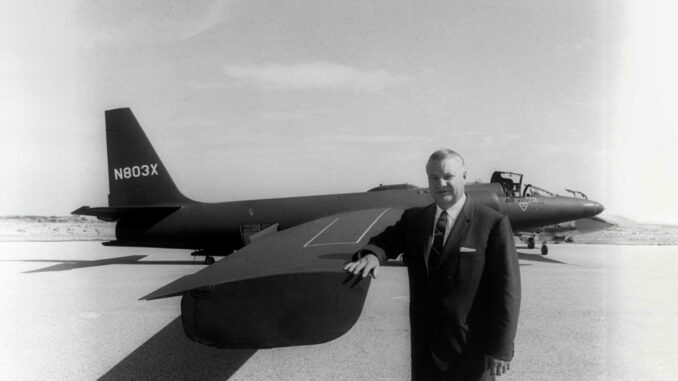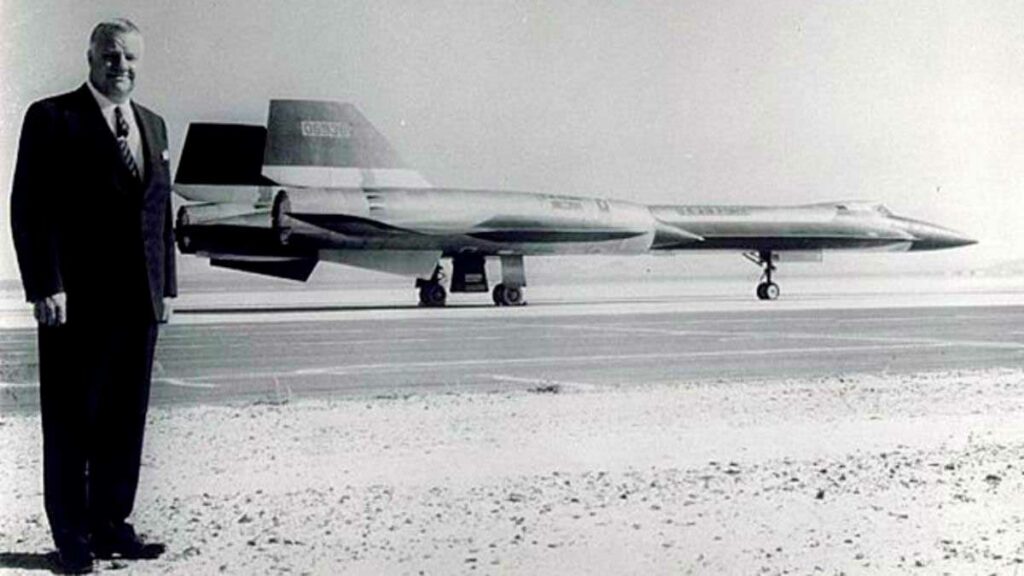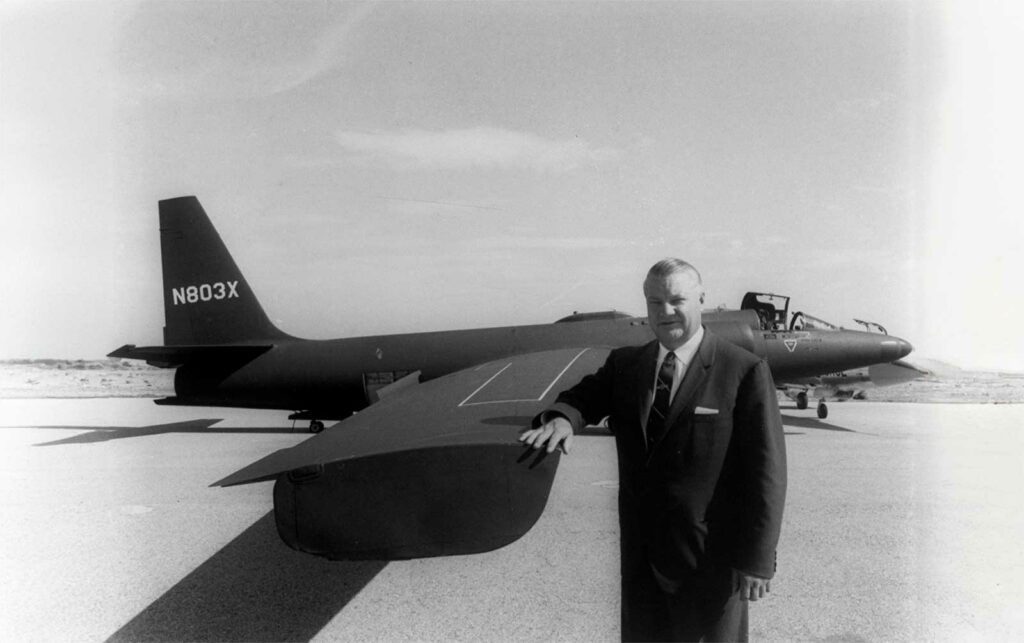
Portrait of Kelly Johnson, aerospace genius, creator of Skunk Works, and head of iconic aircraft development for Lockheed Martin.
Clarence “Kelly” Johnson is recognized as one of the greatest aerospace engineers of the 20th century. A visionary at Lockheed Martin, he founded Skunk Works, the secret research group that revolutionized the aviation industry. From the invention of the U-2 to the SR-71 Blackbird, he transformed aircraft design by creating state-of-the-art machines and innovative concepts, while developing pioneering technologies for surveillance and stealth. Johnson also played a key role in the creation of the famous secret base Area 51, providing solutions to numerous technological challenges.
A historic journey at the heart of aviation
Clarence Leonard “Kelly” Johnson, born on February 27, 1910, in Ishpeming, Michigan, was one of the most brilliant minds in the aerospace industry of the 20th century. The son of Swedish immigrants, he developed a passion for aeronautical engineering at a very young age. After graduating with a degree in aeronautics from the University of Michigan in 1932, Johnson quickly joined the Lockheed Corporation, where he rose through the ranks. From the outset, he distinguished himself with his practical and innovative approach to engineering problems. During his career, he developed more than 40 different aircraft and was awarded numerous honors for his major contributions to aeronautics, including two Collier Trophies and the National Medal of Science. His desire to advance technology while simplifying design processes laid the foundation for Lockheed’s future successes.

Skunk Works: a secret laboratory dedicated to innovation
In 1943, in the midst of World War II, Kelly Johnson created Skunk Works, an advanced research laboratory within Lockheed. This secret facility was created in response to an urgent need to develop an aircraft capable of outperforming enemy fighters. Johnson and his team succeeded in designing the P-80 Shooting Star in just 143 days, a feat that became emblematic of Skunk Works’ “fast and efficient” approach. This design model, focused on economy of means and creativity, was later used in the design of other iconic projects such as the U-2 and the SR-71. Skunk Works operated on the basis of 14 rules established by Kelly, aimed at reducing bureaucracy and encouraging rapid innovation. This laboratory influenced the way the aerospace industry designs top-secret projects, making the Skunk Works team almost mythical among defense technology developers.
Kelly Johnson’s 14 rules
Kelly Johnson’s 14 rules were designed to encourage efficiency and innovation while minimizing bureaucratic obstacles. These rules are still considered a benchmark in complex project management today. Here is an overview of the 14 rules:
*Project manager authority: The project manager must have complete authority over the project, without unnecessary interference.
*A small, dedicated team: The team should consist of highly skilled and dedicated individuals, with a small number of staff to maximize efficiency.
*Direct communication: Lines of communication should be short, allowing for quick decisions without going through bureaucratic processes.
*Minimal documentation: Reduce paperwork to a minimum, focusing efforts on innovation and technical development.
*Single responsibility: The project manager is responsible for all aspects of the project, ensuring consistency and accountability.
*Reliable subcontractors: Subcontractors must be selected for their competence and ability to work to strict deadlines.
*Clear requirements: Requirements must be defined at the outset of the project, reducing changes along the way that can slow down development.
*Frequent testing: Test prototypes regularly to detect problems quickly and resolve them before they become critical.
*Adequate funding: Funding must be sufficient and continuous to avoid interruptions in development.
*Proactive risk management: Identify and mitigate risks early in the project to avoid delays.
*Realistic schedule: The schedule should be tight but achievable, taking into account the team’s capabilities.
*Limited inspections: Limit external inspections and audits to avoid distractions and allow the team to focus on development.
*Effective logistical support: Provide logistical support to ensure that the team has the necessary resources at all times.
*Flexible management: Management must be flexible, allowing for quick adjustments to respond to unexpected challenges.
These rules enabled Skunk Works to carry out ambitious projects with remarkable efficiency, laying the foundation for many of Lockheed Martin’s successes.
Its impact on Lockheed Martin’s development
Under Kelly Johnson’s leadership, Lockheed became an undisputed leader in the aviation industry. Johnson’s involvement in flagship projects such as the Constellation, a transatlantic airliner, made civil aviation history, but his impact was particularly felt in the military sector. The development of the U-2 and SR-71 spy planes propelled Lockheed to the top of the US military’s list of suppliers, with a technological lead that lasted throughout the Cold War. These aircraft were equipped with advanced stealth and reconnaissance technologies, offering flight capabilities at altitudes of over 25,000 meters, far beyond the typical range of surface-to-air missiles. Under his leadership, Lockheed also played a crucial role in the creation of the secret Area 51 test base, enabling testing in isolated conditions, which was essential for maintaining the confidentiality of projects.
Iconic aircraft developed by Kelly Johnson
Among the most iconic aircraft developed under Johnson’s leadership was the U-2, a spy plane that could operate at very high altitudes, reducing the risk of interception by the enemy. The SR-71 Blackbird, designed to reach supersonic speeds (over Mach 3, or approximately 3,675 km/h), was one of the most daring achievements. This aircraft is still celebrated today for its unique performance in terms of speed and altitude. The F-104 Starfighter, nicknamed “the missile with a man in it,” was also designed under his leadership. With its slender silhouette and very short wings, the F-104 marked a move toward ever-greater performance and increased interception speed.
Advanced technologies developed by Skunk Works
Kelly Johnson was at the forefront of many technological innovations. In particular, he was behind the first stealth technologies designed to reduce the radar signature of aircraft. With the SR-71, for example, Johnson introduced a titanium structure to withstand the high temperatures associated with supersonic flight. The Skunk Works teams also developed innovative propulsion systems such as the Pratt & Whitney J58, capable of operating at hypersonic speeds. This approach was extended to future generations of military aircraft, for which stealth remains a key element of operations. In addition, Skunk Works pioneered the development of aerial reconnaissance systems that were used successfully during the Cold War to obtain essential strategic information.

The construction of the secret Area 51 base
Kelly Johnson’s role in the creation of Area 51 remains one of the most intriguing aspects of his career. In 1955, he recommended the use of an isolated area in Nevada to test U-2 spy planes under optimal security conditions. Area 51 subsequently became a top-secret testing site, used to test prototypes away from prying eyes. Johnson understood the importance of protecting military secrets and the need for a remote, well-equipped site for testing. This site was also crucial for the development of the SR-71 and other classified projects. Area 51 is still associated today with aeronautical innovation and the most confidential projects in the United States.
An undeniable legacy in the aeronautics industry
Kelly Johnson left a lasting legacy in the field of aeronautics and defense. His innovative approach to aircraft design and project management changed the way aerospace companies design and manufacture their aircraft. His work ethic, focused on problem solving and reducing red tape, enabled the rapid creation of aircraft that redefined technological boundaries. Lockheed Martin continues to benefit from the legacy left by Skunk Works and Kelly Johnson. Many of the concepts he introduced are still relevant today, whether it’s stealth, advanced propulsion, or the importance of a close-knit team capable of working efficiently, discreetly, and quickly. Kelly Johnson was not only a brilliant engineer, but also a visionary whose influence is still felt today in every stealth aircraft or drone developed by Lockheed Martin.
War Wings Daily is an independant magazine.